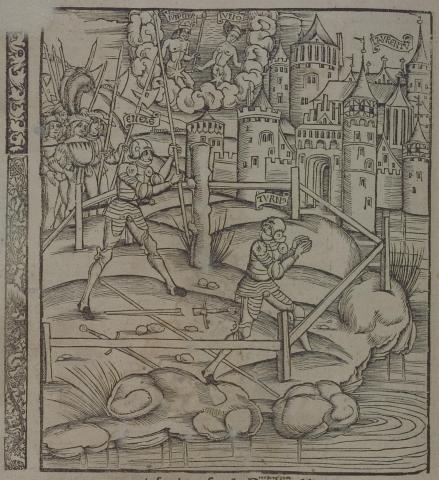Annotations
In the fighting ring, Aeneas struggles to retrieve his spear from the stump of an olive tree (766-76). Turnus prays to Faunus, to whom the tree was sacred, to delay Aeneas's success in obtaining the spear until he himself is armed (776-9). Above this scene, Jupiter confronts Juno, who watches Turnus from the clouds (791-806). She agrees to stop thwarting Aeneas and helping Turnus as long as the victory of Aeneas does not create a new Troy, but instead a stronger Latium (808-42). In this image, the artist has placed the fighting ring right at the edge of the water, though other images do not show it anywhere near the water, and Vergil makes it clear that the fighting happens on a large plain. The water may be intended to enhance the fenced-in feeling of the ring itself.
Woodcut illustration from the “Strasbourg Vergil,” edited by Sebastian Brant: Publii Virgilii Maronis Opera cum quinque vulgatis commentariis expolitissimisque figuris atque imaginibus nuper per Sebastianum Brant superadditis (Strasbourg: Johannis Grieninger, 1502), fol. 407v, executed by an anonymous engraver under the direction of Brant.


Sebastian Brant (1458-1521) was a humanist scholar of many competencies. Trained in classics and law at the University of Basel, Brant later lectured in jurisprudence there and practiced law in his native city of Strasbourg. While his satirical poem Das Narrenschiff won him considerable standing as a writer, his role in the transmission of Virgil to the Renaissance was at least as important. In 1502 he and Strasbourg printer Johannes Grüninger produced a major edition of Virgil’s works, along with Donatus’ Life and the commentaries of Servius, Landino, and Calderini, with more than two hundred woodcut illustrations. (Annabel Patterson)